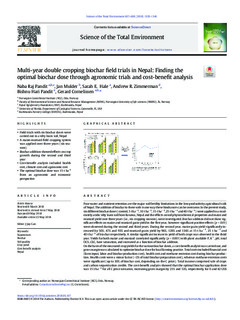Multi-year double cropping biochar field trials in Nepal: Finding the optimal biochar dose through agronomic trials and cost-benefit analysis
Pandit, Naba Raj; Mulder, Jan; Hale, Sarah; Zimmermann, Andrew R.; Pandit, Bishnu Hari; Cornelissen, Gerard
Peer reviewed, Journal article
Published version
Permanent lenke
http://hdl.handle.net/11250/2574264Utgivelsesdato
2018Metadata
Vis full innførselSamlinger
- NGI articles [1037]
Originalversjon
Science of the Total Environment. 2018, 637-638 1333-1341. 10.1016/j.scitotenv.2018.05.107Sammendrag
Poor water and nutrient retention are the major soil fertility limitations in the low productivity agricultural soils of Nepal. The addition of biochar to these soils is one way these hindrances can be overcome. In the present study, six different biochar doses (control, 5 t ha−1, 10 t ha−1, 15 t ha−1, 25 t ha−1 and 40 t ha−1) were applied to a moderately acidic silty loam soil from Rasuwa, Nepal and the effects on soil physicochemical properties and maize and mustard yield over three years (i.e., six cropping seasons), were investigated. Biochar addition did not show significant effects on maize and mustard grain yield in the first year, however significant positive effects (p < 0.01) were observed during the second and third years. During the second year, maize grain yield significantly increased by 50%, 47% and 93% and mustard grain yield by 96%, 128% and 134% at 15 t ha−1, 25 t ha−1 and 40 t ha−1 of biochar respectively. A similar significant increase in yield of both crops was observed in the third year. Yields for both maize and mustard correlated significantly (p < 0.001) with plant available P, K+, pH, total OC%, CEC, base saturation, and increased as a function of biochar addition. On the basis of the measured crop yields for the various biochar doses, a cost-benefit analysis was carried out, and gross margin was calculated to optimize biochar dose for local farming practice. Total costs included financial cost (farm input, labor and biochar production cost), health cost and methane emission cost during biochar production. Health costs were a minor factor (<2% of total biochar preparation cost), whereas methane emission costs were significant (up to 30% of biochar cost, depending on the C price). Total income comprised sale of crops and carbon sequestration credits. The cost-benefit analysis showed that the optimal biochar application dose was 15 t ha−1 for all C price scenarios, increasing gross margin by 21% and 53%, respectively, for 0 and 42 US$ per ton CO2 price scenarios. In the current situation, only the 0 US$ price scenario is realistic for rural farmers in Nepal, but this still gives benefits of biochar amendment, which are capped at a 15 t ha−1 biochar addition. Multi-year double cropping biochar field trials in Nepal: Finding the optimal biochar dose through agronomic trials and cost-benefit analysis
